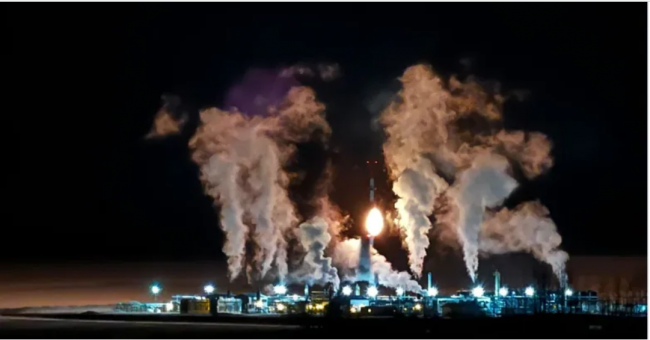Articles Menu

Apr. 27, 2022
When Kevin McCleary and his wife cleared 160 acres of land to build their home in Pouce Coupe, B.C., two decades ago, they didn't expect a hydraulic fracturing gas well pad would be built less than half a kilometre from their front door.
Now, McCleary says his family is bombarded by bright lights, foul smells and high-decibel industrial noise from the work site near the community, which is a few kilometres southeast of Dawson Creek in the province's northeast.
"It's an incredible roaring sound, which builds up to a crescendo," said McCleary. "The lights illuminate our front yard. There always seems to be something on the wind, some oily, chemical substance, or diesel exhaust.
"It's disturbing our sleep. We were trying to watch television last night and we can hear down at the pad site the banging and kind of rumbling and roaring sound."

Hydraulic fracturing, or fracking, is a process that blasts water, sand, and chemicals at high pressure more than two kilometres underground to release natural gas trapped in rock formations.
That gas is then moved by pipelines, like the 670-kilometre Coastal GasLink pipeline that's being constructed across northern B.C., to processing facilities like the plant LNG Canada is building in Kitimat for shipping to export markets.
But fracking remains controversial and has already been banned in some jurisdictions.
While the industry is key to the B.C.'s government's economic plans and job forecasts, those who have seen fracking sites set up near their homes feel they are being made to pay the price for energy development.

In Farmington, around 25 kilometres northwest of Dawson Creek, Vicky Simlik said she feels under siege.
The 80-acre property where she's lived for three decades, raising horses and growing hay, used to be idyllic. But ever since a fracking well pad was built less than a kilometre away, she avoids going outside because of the noise and industrial smells.
"I feel anger and grief," she said. "It sounds like a train right in front of you that just keeps going and going and going. It's so invasive, it can break you in half.
"The fracking is just kickboxing its way across the land."
Wayne Sawchuk grew up in the region and now lives in Rolla, B.C., where he can see flares from a nearby gas plant.
Sawchuk describes northeast B.C. as a "sacrifice zone" where well pads, pipelines and resource roads are "carving up the land."
"In my lifetime, every area has been accessed, almost without exception," he said.
"To go from a pristine landscape to ... basically an industrialized landscape ... this oil and gas [development] is not benign. And I've lived through it. I've seen it."
The B.C. government and scientists are still studying fracking's impact on human health, the environment, greenhouse gas emissions and water supplies, as well as its link to induced earthquakes.
But while it feels like a threat to some, for others it's a major opportunity.
Thousands of people are now at work building the Coastal GasLink pipeline and LNG Canada's processing and export facility.
The combined project is also a boon to businesses servicing the oil and gas sector, like family company Lindberg Construction in Dawson Creek.
Owner Gerald Lindberg says natural gas development has brought stability to the boom-and-bust cycle.
"It really brings new life to the area. Now that everyone's working, a lot of our guys are able to afford houses and start families, so it's hugely beneficial to us," he said.

Of course, it's also beneficial to companies like Shell and Petronas, two of the partners in the LNG Canada joint venture, and among the biggest gas producers in the region.
The new pipeline and export facility will ensure more natural gas makes its way to Asian markets.
"There hasn't been enough pipelines to take away all this gas," said Tommy Chu, an engineer and energy analyst.
"So what LNG Canada is going to provide is much needed relief to access additional markets. Companies have kind of been waiting in the wings. Now, we'll see a lot more activity."

At current prices, Chu estimated $10 million worth of gas a day will flow through the Coastal GasLink pipeline once the LNG project is operational.
The revenue from gas extraction is vital, said Deborah Yedlin, president and CEO of the Calgary Chamber of Commerce.
"These revenues fund health care, social services, education and infrastructure. To shut the door because we see obstacles … anything you do will have an impact. From a fracking standpoint, the technologies and the processes are evolving continuously," she told CBC News.
In 2021, B.C.'s energy regulator tallied just over 8,200 gas wells and 39,000 kilometres of pipelines operating in the province.
The B.C. Oil and Gas Commission (BCOGC) said drilling for new wells was up 24 per cent last year.

LNG Canada is still considering whether to double the project's future capacity as part of a possible Phase 2 expansion.
Petronas, one of the joint venture partners in LNG Canada, said there are "over 15,000 identified drilling locations" in northern B.C. — though it clarified in an email to CBC News that the number of actual well pads "will be significantly lower and spread out over the lifespan of our operations."
A Shell spokesperson told CBC that any increase in production will depend on "future market conditions."
Back in Pouce Coupe, McCleary fears further growth in fracking in the region "will drive us from our homes."
He said when he complained about constant noise, he was advised to try ear plugs.
The BCOGC said the province's regulations "ensure oil and gas companies are developing energy resources responsibly, while also protecting public safety, safeguarding the environment, and respecting those affected."
[Top photo: A gas plant near Rolla, B.C. The province's energy regulator says there are more than 8,000 active gas wells and 39,000 kilometres of pipelines in B.C. (Contributed/Wayne Sawchuk)]